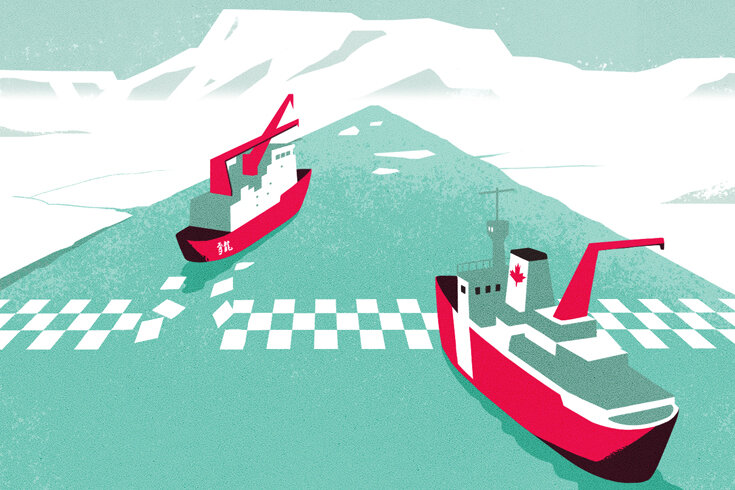The vast mineral deposits of zinc and copper near Izok Lake, in the Northwest Territories, lay glittering but ultimately untouchable until August 2019, when transport minister Marc Garneau pledged $21.5 million in federal funding toward the first phase of development for the Grays Bay Road and Port Project, a transportation network designed to cash in on the opening of the Arctic. This money would add to the $40 million allocated to building a series of roads across the Nunavut–Northwest Territories border, which will help connect Izok Lake to the deepwater port at Nunavut’s Grays Bay, located along the increasingly ice-free Northwest Passage sea route that leads to Asia.
Listen to an audio version of this story
For more audio from The Walrus, subscribe to AMI-audio podcasts on iTunes.
In 2011, MMG Limited, a multinational mining corporation, expressed interest in building a road to open up some of the Arctic’s remote but lucrative mineral reserves. Standing to benefit most from this would be the corporation’s primary shareholder: the Chinese government. The tremendous cost of the road and port, however, ultimately made the project economically unviable for MMG, which halted further development, in 2013, in hopes that Canada would pick up the shovel. “On behalf of MMG, I would like to extend my sincere thanks to the Canadian government for their support and funding,” CEO Geoffrey Gao said in a press release following Garneau’s pledge. “Road and port access is the key to unlocking the Izok Corridor.”
For Stanley Anablak, president of the Kitikmeot Inuit Association, an organization that represents Inuit in western Nunavut, it mattered not whether investment came from Canada or from abroad. Investment had been held back largely by limited backbone infrastructure in the territories. More roads and ports, better broadband networks and transmission lines, and even railways, Anablak notes, could change that. “Without this project, we will continue to be dependent on the [few] mines that can operate completely independent of regional infrastructure,” he wrote in an email. “We want to be more self sufficient. We need to be in charge of our own destiny.”
With the entire transportation network project bearing a $1.6 billion price tag, the $61.5 million in Canadian funding seemed a drop in the bucket, but it is what that money represents that concerns Michael Byers, a Canada Research Chair in global politics and international law at the University of British Columbia who has monitored the development for years. “I don’t see a need for us to be subsidizing Chinese investments in the Canadian Arctic,” he says. He believes economic benefits to Inuit communities are oversold. “[The road] has one purpose, which is to support mineral development in the region . . . and the primary commercial beneficiary will be a Chinese company.”
There is growing concern that China’s influence in the North could threaten Canada’s autonomy in the region and put politicians in uncomfortable situations as they weigh national regulations with foreign-policy strategies. Canada has spent decades ignoring its Arctic potential, and as a result, the region’s economy lags far behind that of most other northern regions around the world. Evidently, the Canadian Arctic has not proven such a blind spot for China.
China’s growing interest in the Canadian Arctic, one of the least defended regions on earth, has been a calculated move. In 2013, despite not being one of the eight Arctic nations, China gained official observer status at the Arctic Council, an intergovernmental forum, and later declared itself a “near-Arctic state”—a phrase that seems to ignore the 5,000 kilometres between its northernmost point and the Arctic Circle. The Chinese government has focused largely on the Russian and European Arctic, but in its scramble for resources and transportation domination, that is beginning to change. In Greenland, for example, as the ice sheet recedes, precious metals, gemstones, rare earth elements, and uranium are suddenly becoming accessible. China now controls over 90 percent of the global trade of rare earth minerals, according to a report from the Institute for the Analysis of Global Security, and a Chinese company is forging ahead with a mine at the world’s second-largest rare earth element deposit, in Greenland. “A big reason the Canadian North trails the Russian Arctic, and even Greenland, in resource extraction and development is that it’s just so hard to get in there, build things, and get the product out to market,” explains Adam Lajeunesse, a researcher in Canadian Arctic marine-security policy at St. Francis Xavier University.
Forty percent of Canada lies in the Arctic—an area with abundant deposits of oil, gas, and minerals. And Chinese companies have already helped finance the Nunavik nickel mine and Lac Otelnuk iron project in the sub-Arctic of northern Quebec. Lajeunesse says that Chinese investment in the Arctic is something he’s been anticipating. And the country’s advance toward the Arctic Circle will likely be aided by warming temperatures. In 2017, the icebreaker Xuelong, or Snow Dragon, made its first voyage through the Northwest Passage, which Canada recognizes as internal waters. The United States has long contested Canada’s sovereignty here, but as Lajeunesse explains, “China’s position on the Northwest Passage is purposefully ambiguous.” And, while the Chinese government has said it respects Canadian sovereignty in the region, it plans to freely use the transit passages. Arguing against Canadian sovereignty, Lajeunesse says, would make operating in the Canadian North more difficult; this way, China reserves the right to challenge Canada’s claim during future diplomatic negotiations. Given the dangers of operating in undercharted waters, foreign nations must rely on the support of the Canadian Coast Guard to ensure safe shipping.Sea ice, storms, and icebergs could all spell disaster.
China is already a key supporter of the Northern Sea Route, the once frozen shipping lane opening up above Russia that’s expected to shave as much as two weeks off transit times between Europe and Asia. And, at the mouth of the Yangtze River in Shanghai’s Jiangnan Shipyard, Chinese and Finnish architects recently finished construction on the nation’s second heavy icebreaker. Closing bids for a third, China will soon have more heavy icebreakers than most of the actual Arctic nations. In 2018, the country released its first Arctic policy paper, laying out plans for a “Polar Silk Road”—an Arctic extension of its in famous transportation megaproject, the Belt and Road Initiative, which currently spans more than 130 countries. The paper focused on China’s altruistic aims: the Chinese government hoped to understand the Arctic through research, protect it against climate change, and promote peace. But the paper also stated plans to extract resources and participate in the Arctic’s governance. Where does that leave Canada, the nation with the second-largest share of the Arctic, behind Russia?
“Some Chinese academics talk about the Arctic region as possibly the second Middle East.”
The Canadian government has been slow to wake up to China’s Arctic ambitions. “We’ve not been paying attention, both defensively and opportunistically, to the Arctic,” says Irvin Studin, president of the Institute for 21st Century Questions. Rather, we’ve focused solely on relations with our neighbouring global powerhouse. It wasn’t until April 2019 that the House of Commons updated its report on Canada’s Arctic sovereignty, which recommended that the country “should engage with the Government of China to understand their growing interest in the Arctic.” Engaging with China, however, has proven difficult. With the 2018 arrest and attempted extradition of Huawei executive Meng Wanzhou, whatever goodwill existed between the two countries vanished. Soon afterward, China detained two Canadians, including a diplomat. (China denies this was retaliation.)
Despite a tense moment in the history of China–Canada relations, Byers says there is zero potential for militarized conflict with China in Canada’s North. Rather, China’s Arctic interests will take the form of strategic investment and acquisitions. In 2013, China acquired Nexen, a Calgary-based oil-and-gas company, in a $15.1 billion deal that essentially transferred a portion of Alberta’s oil-sands wealth to China. “China is very good at diversifying,” says Petra Dolata, a former University of Calgary Canada Research Chair in the history of energy. “Some Chinese academics talk about the Arctic region as possibly the second Middle East.”
Currently, there’s no offshore oil-and-gas drilling in the Canadian Arctic: a five year moratorium between the US and Canada blocked the issuance of any new licences in the Arctic Ocean. But that agreement is up for review in 2021. In the interim, China is focusing on its mining portfolio.
This May, the country entered a bid to purchase struggling mining company TMAC Resources, which operates the Doris North gold mine, in Hope Bay, Nunavut. The company’s shareholders later voted in favour of the company’s sale to Shandong Gold Mining, a state owned enterprise and the second-largest gold-mining company in China. This upset Yellowknife North MLA Rylund Johnson. “China is writing the cheques now and the government of Canada is not,” he says. “Canada is not willing to give Indigenous people in the North enough money to survive. They’re not willing to build the necessary infrastructure. When China shows up, people here don’t have a choice. . . . We’re losing out on Arctic sovereignty.” He’s fearful of a future when the Canadian government has to regulate foreign-owned enterprises or dole out punishments following an industrial disaster in the Arctic. “I don’t want to have to pass laws thinking, ‘Is this going to anger the Chinese government?’” (After this article went to print, Canada rejected the sale of TMAC Resources, a Canadian mining company, to Chinese state-owned Shandong Gold Mining, citing national security concerns.)
China’s emergence as a major player in the Canadian Arctic doesn’t alarm everyone. Speaking at a 2019 conference on Arctic affairs, then Northwest Territories premier Bob McLeod addressed the room: “Iqaluit to Oslo is 3,900 kilometres, compared to almost 6,000 from Toronto. And a 10,500 kilometre flight from Toronto to Beijing would be reduced to 6,600 kilometres from Inuvik.” The message was clear: Canada’s North was far more aligned with certain major global trading blocs than the rest of the country was. China was an opportunity, not a threat.
Indeed, many see China’s interest as a pathway for Indigenous people in the North to gain more control over their economic futures. “If you are serious about Indigenous agency,” says the University of Calgary’s Dolata, “then some of those communities will say, ‘If the Chinese want to work with us, bring infrastructure here, we will happily do this.’” It has happened in Greenland, where Inuit groups have aligned themselves with Chinese investors instead of with Copenhagen. Now, it’s happening across Canada’s Arctic regions. “The Kitikmeot region has enjoyed a reputation of being open to business,” Kitikmeot Inuit Association president Stanley Anablak notes. “But being open does not mean being naive or soft.” Any Arctic investor, he explains, must ad here to not only Canada’s and Nunavut’s laws but also Inuit protections of the land. “The Kitikmeot regions compete with many other international mining districts for this investment. We are open to receiving investment whether it is from Canadian or foreign companies.”
Though the prime minister’s attention may be focused elsewhere, northern actors have been paying close attention to Chinese developments in the Arctic and weighing how they might realize the region’s economic potential. “We have two new borders this century,” says Irvin Studin. “One is the Arctic border that’s melting. And we have a western border with China. For over 150 years of Canadian existence, China was a destabilized former empire. Now, it’s got its act together.”





